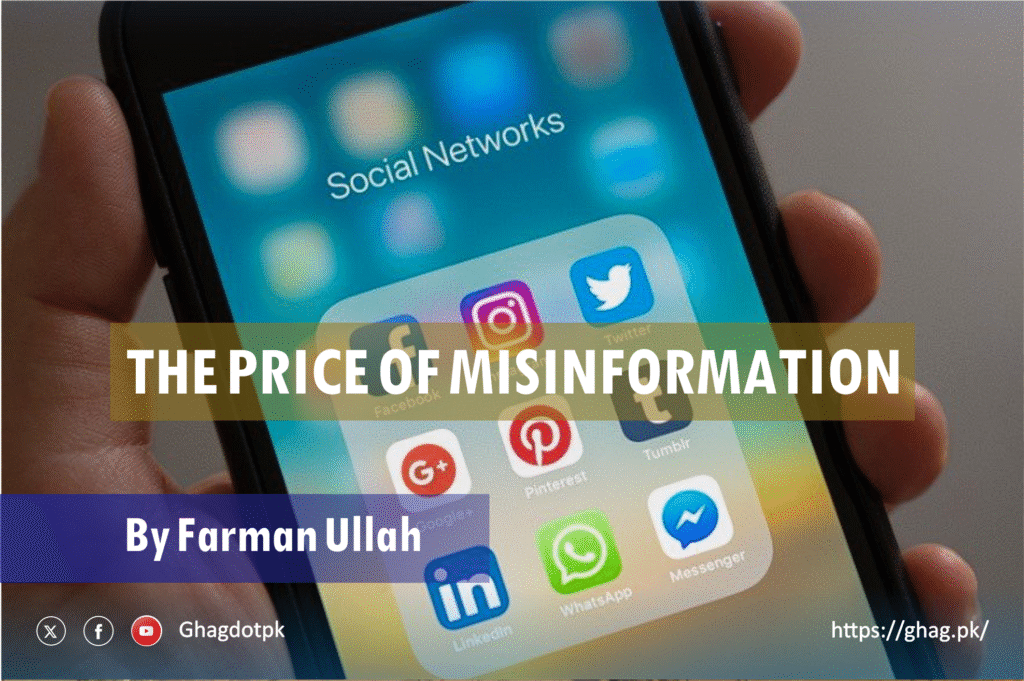By Farman Ullah
In the bustling streets of Karachi, where the hum of rickshaws mingles with the chatter of vendors, a young man named Asif scrolls through his smartphone, his thumb flicking past a barrage of WhatsApp messages, X posts, and YouTube videos. A notification catches his eye: a grainy video claiming that a new miracle cure for dengue fever is being suppressed by the government. The post, shared by a popular influencer, urges people to boil neem leaves and drink the concoction. Asif forwards it to his family group without a second thought. Within hours, his cousin, a diabetic, falls ill after trying the remedy, landing in a hospital bed. This is not an isolated incident. It is a symptom of a larger malaise that has gripped Pakistan: the unchecked spread of misinformation, a force as potent and perilous as any physical epidemic. The price of misinformation in Pakistan is not just measured in hospital visits or wasted resources—it is paid in lives lost, trust eroded, and a society fractured by falsehoods.
Pakistan, a nation of over 240 million people, stands at a digital crossroads. With internet penetration reaching 40% in 2025 and social media platforms like WhatsApp, X, and YouTube shaping public discourse, the country has become a fertile ground for misinformation. The rapid adoption of smartphones, coupled with low digital literacy, has created a perfect storm where false narratives spread faster than verified facts. From vaccine conspiracies to political propaganda, misinformation has permeated every facet of Pakistani life, influencing elections, inciting violence, and undermining public health efforts. The consequences are profound, and the stakes are high in a country already grappling with economic instability, political polarization, and security challenges.
The roots of misinformation in Pakistan are deep and multifaceted.The 2017 lynching of Mashal Khan, a student falsely accused of blasphemy on social media, remains a stark reminder of how a single unchecked narrative can lead to tragedy. The mob that killed him was fueled by rumors spread on WhatsApp and Facebook, amplified by a lack of critical scrutiny among the public.
The COVID-19 pandemic exposed the fragility of Pakistan’s information ecosystem. As the virus spread in 2020, so did false claims about cures and vaccines. One viral WhatsApp message suggested that drinking “sana makki” (senna leaves) could cure COVID-19, leading to a surge in hospital admissions for severe diarrhea. Another post, shared thousands of times, claimed that the polio vaccine was a Western conspiracy to sterilize Muslim children, echoing decades-old myths that have hampered Pakistan’s polio eradication efforts. A 2025 article in The Express Tribune recounted the story of a man whose parents refused to vaccinate him against polio due to such conspiracies, leaving him disabled for life. These incidents highlight how misinformation preys on cultural and religious sensitivities, exploiting trust in community networks to spread falsehoods.
The political sphere is equally vulnerable. During the 2023 protests following the arrest of former Prime Minister Imran Khan, false reports of military defections and staged videos of violence flooded X and WhatsApp. These narratives, often amplified by influencers with large followings, deepened public distrust in institutions. A 2022 report by South Asian Voices noted that Pakistan’s deepening domestic polarization and mistrust of neighboring India provide ample space for disinformation, which can escalate interstate crises and distort electoral processes.
The economic cost of misinformation is staggering. During the COVID-19 crisis, panic-buying triggered by false claims about drug shortages led to a black market for hydroxychloroquine and ivermectin, drugs with no proven efficacy against the virus. A 2020 study published in Disaster Medicine and Public Health Preparedness highlighted how misinformation fueled the misuse of lifesaving drugs, causing shortages for patients with chronic illnesses. In agriculture, rumors about genetically modified crops being poisonous have deterred farmers from adopting high-yield varieties, exacerbating food insecurity in a country where 40% of the population lives below the poverty line. The economic ripple effects extend to businesses, as false reports of product contamination or corporate conspiracies can devastate brands and livelihoods overnight.
Public health campaigns have borne the brunt of misinformation’s toll. Pakistan remains one of only two countries where polio is endemic, largely due to persistent vaccine hesitancy fueled by false narratives. A 2019 attack on polio workers in Khyber Pakhtunkhwa, sparked by rumors that vaccines caused infertility, left health workers dead and vaccination drives stalled. The World Health Organization has warned that misinformation, or the “infodemic,” amplifies health crises by undermining trust in medical authorities. In Pakistan, where only 47% of the population has basic digital literacy, according to a 2019 International Telecommunications Union report, the ability to discern credible information is limited, leaving millions vulnerable to manipulation.
The role of influencers in this ecosystem cannot be overstated. Unlike journalists, who operate under editorial oversight, influencers often lack accountability, prioritizing engagement over accuracy. A 2025 UNESCO report found that 42% of influencers gauge credibility based on likes and shares rather than verification, perpetuating a cycle where sensationalism trumps truth. In Pakistan, influencers with millions of followers on YouTube and TikTok have been known to spread unverified claims about everything from political scandals to miracle cures, often for financial gain. The same UNESCO report noted that 52% of influencers create sponsored content without disclosing funding sources, raising ethical questions about their motives. This profit-driven model thrives on controversy, as outrage generates clicks, views, and revenue.
Social media platforms, while democratizing access to information, have also weaponized misinformation. WhatsApp, with its end-to-end encryption, is a breeding ground for unchecked rumors, particularly in Pakistan’s tightly knit community groups. A 2022 study on arXiv analyzed misinformation on WhatsApp, X, and YouTube in Pakistan, finding that public WhatsApp groups were particularly prone to sharing false narratives about the COVID-19 pandemic. The study noted that while some users could identify outright falsehoods, such as manipulated news headlines, many lacked the tools to verify complex claims. X, meanwhile, has become a hub for viral misinformation, with only a fraction of misleading posts flagged by Community Notes, according to a 2025 report by the Center for the Study of Organized Hate.
The government’s response to misinformation has been a double-edged sword. The Pakistan Electronic Media Regulatory Authority (PEMRA) has issued show-cause notices to channels like Ary News for airing unverified reports, such as Imran Khan’s 2022 claim of a foreign conspiracy to oust his government. However, heavy-handed measures like internet shutdowns and content bans have drawn criticism for stifling free speech. The 2021 Freedom on the Net Index ranked Pakistan as “not free,” citing restrictive laws like the Prevention of Electronic Crimes Act (PECA), which critics argue is used to silence dissent rather than combat misinformation. A 2020 ResearchGate study emphasized the need for a balanced approach that encourages free expression while curbing falsehoods, warning that censorship often backfires by fueling distrust.
Educational interventions offer a glimmer of hope but face significant hurdles. A 2021 randomized experiment in urban Pakistan, published on arXiv, tested two approaches to counter misinformation among low-digital-literacy populations. While generic video-based messages had little impact, personalized feedback based on individuals’ engagement with fake news improved their ability to identify falsehoods by 0.14 standard deviations. However, the study also found that such interventions could inadvertently reduce trust in legitimate news, particularly among women, highlighting the complexity of addressing misinformation without undermining credible sources. Media literacy programs, while promising, are limited by Pakistan’s education system, where only 59% of adults are literate, and digital skills are rarely taught in schools.
The societal impact of misinformation extends beyond individual incidents to the very fabric of Pakistan’s democracy. False narratives about election rigging have fueled distrust in the electoral process, with a 2023 survey by the Pakistan Institute of Legislative Development and Transparency showing that 62% of Pakistanis believe elections are manipulated. During the 2018 elections, doctored images and videos targeting political candidates spread widely on social media, swaying public opinion and deepening polarization.Such incidents erode the public’s faith in institutions, creating a vicious cycle where misinformation thrives in the absence of trust.
The India-Pakistan conflict of 2025 provided a stark illustration of misinformation’s geopolitical ramifications.The Washington Post reported that Indian newsrooms, once considered credible, were inundated with falsehoods, amplifying nationalist fervor. In Pakistan, a video of a 2020 Lebanon explosion was circulated as evidence of a missile attack on India, as noted by News on Air. These tactics, reminiscent of Russia’s propaganda in the Ukraine conflict, highlight how misinformation can escalate crises, pushing nuclear-armed neighbors closer to war.
The human cost of misinformation is perhaps its most devastating toll. The 2017 lynching of Mashal Khan was not an anomaly but part of a broader pattern. In 2019, a mob in Sindh attacked a Hindu temple based on false WhatsApp messages about blasphemy, sparking communal violence. During the 2020 Karachi floods, misinformation about dam breaches led to unnecessary evacuations, straining emergency resources. These incidents reflect a society where trust in institutions is fragile, and rumors fill the void. The emotional toll on victims and their families is immeasurable, as false accusations can destroy reputations, livelihoods, and lives in an instant.
Addressing misinformation requires a multipronged approach, but solutions are fraught with challenges. Strengthening fact-checking institutions, like Pakistan’s Sachee Khabar, is a start, but their reach is limited in a country where Urdu-language content dominates and English-language fact-checks are inaccessible to many. The government’s covid.gov.pk website, launched to counter pandemic-related misinformation, was a step in the right direction but lacked the reach to compete with viral WhatsApp forwards. Media literacy programs, as recommended by UNESCO, must be integrated into school curricula, but this requires investment in an education system already stretched thin. Social media platforms, meanwhile, face pressure to improve moderation, but only 73 of 437 misleading X posts during the 2025 India-Pakistan conflict were flagged, according to the Center for the Study of Organized Hate.
Legislative reforms could help, but they must balance freedom of expression with accountability. Pakistan’s Article 19, which guarantees free speech with “reasonable restrictions,” needs clearer guidelines to prevent misuse under laws like PECA. The European Convention on Human Rights offers a model, emphasizing proportionality and necessity in restricting content. However, as a 2020 ResearchGate study noted, censorship often exacerbates misinformation by driving it underground, where it spreads unchecked. Public awareness campaigns, coupled with transparent algorithmic accountability from platforms like X and WhatsApp, could reduce the spread of falsehoods without stifling dissent.
The role of journalists in combating misinformation is critical but increasingly perilous. Pakistan ranks 157th on the 2022 Press Freedom Index, and journalists face threats from both state and non-state actors.
The price of misinformation in Pakistan is a tax on progress, paid in fractured communities, lost lives, and eroded trust. Asif’s cousin, recovering in a Karachi hospital, is a victim of this tax, as is the farmer who shuns modern seeds, the voter swayed by a doctored video, and the nation teetering on the edge of conflict fueled by lies. The path forward lies in education, transparency, and a collective commitment to truth. Pakistan stands at a crossroads: it can invest in a future where facts prevail, or it can surrender to a digital battlefield where misinformation reigns. The choice will shape not just the present but the destiny of a nation striving for stability and progress.
The fight against misinformation is not just a policy challenge; it is a moral imperative. As Oscar Wilde’s words remind us, truth is complex, but its pursuit is non-negotiable. In Pakistan, where every forwarded message carries the weight of consequence, the cost of inaction is too high. The time to act is now—before the next viral lie claims another life, another trust, another future.






